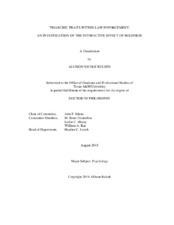| dc.description.abstract | Psychopathic personality disorder (psychopathy) is generally construed as a constellation of affective/interpersonal deficits and externalizing behaviors/deviance; these characteristics are often considered maladaptive and perceived as highly socially undesirable. However, perceptions of psychopathy are not uniformly negative and ostensibly psychopathic traits are not uniformly predictive of adverse outcomes. Recent conceptualizations of the disorder have captured putatively adaptive traits (i.e., boldness) as central features of their nomological network, which is consistent with some historical conceptualizations of the disorder. One such model, the Triarchic Model of psychopathy, is comprised of three distinct dispositional variables: disinhibition, meanness, boldness. Recent criticisms regarding the inclusion of boldness in conceptual models of psychopathy have tended to focus on the fact that this construct appears to be a socially desirable personality trait that also tends to be associated with adaptive functioning and outcomes. But is it truly desirable/adaptive to be bold?
The current project addressed this question in two separate but related domains. Study 1 examined the extent to which a police officer perceived as bold is judged positively or negatively across contexts. Building on recent mock juror research demonstrating that perceived boldness among criminals is judged negatively by jurors, a 3x2 research design was employed to manipulate a fictitious police officer’s personality (high boldness, low boldness, none) and the “context” (positive versus negative outcome) using a simulation approach. Counter to the hypotheses, an interactive effect
of outcome by boldness on perceptions of the officer, such that the main effect of outcome (i.e., positive outcome associated with more positive perceptions) was amplified by high boldness and attenuated by low boldness, did not consistently emerge.
Study 2 more directly investigated whether traits of psychopathy (particularly boldness) are endorsed by police officers, and if so, the relation to actual performance among police. Specifically, this study used archival data from extant personality measures (i.e., MMPI-2 and PAI) as a preliminary investigation into Triarchic trait endorsement and the impact of boldness on supervisor judgments of police officers. Although not predictive of supervisor judgments, officer candidates tended to portray themselves as highly bold and low in meanness and disinhibition—a pattern that was amplified by defensive responding. | en |


